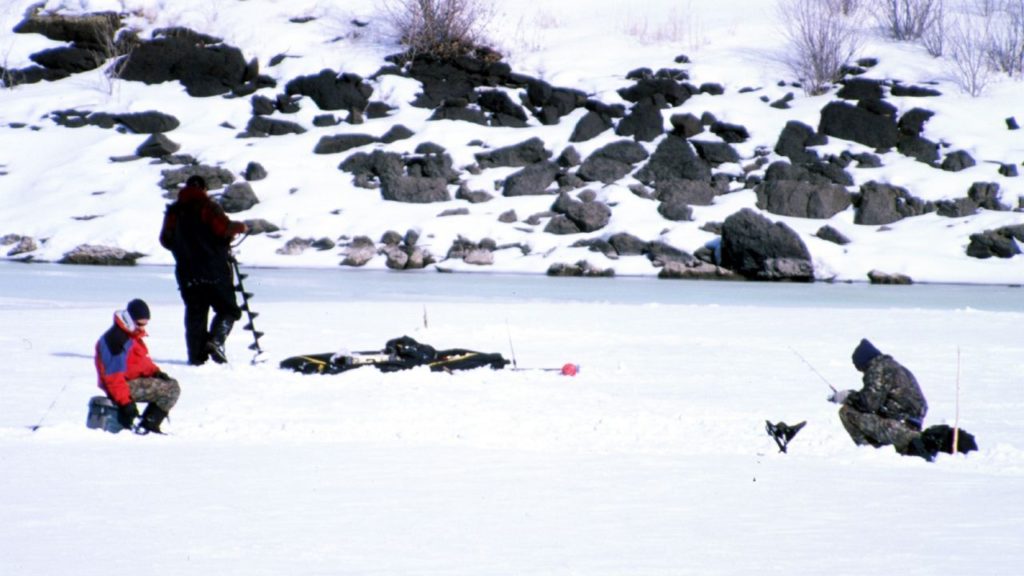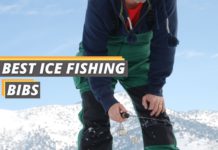Archaeologists say that the first North American ice fishermen plumbed the depths of frozen bodies of water more than 2000 years ago. It took ingenuity to carve out holes and wait patiently for fish, primitive wood, and bone spears at the ready. Happily, you don’t have to follow in their footsteps to feed your family, but if this sport looks like fun, you’ll carry on a long tradition, albeit with ice fishing gear those primitive ice fishermen would have envied.
What Is Ice Fishing?
As the name implies, ice fishing involves fishing on a frozen body of water. But how, you ask? You will need to drill a hole using one of the most crucial ice fishing gear – the auger. Once you have an opening, you’ll use a line or hook and wait patiently for a fish to nibble your lure.

Much like other outdoor sports and activities, beginners and pro anglers must comply with ice fishing rules and regulations, including maintaining a safe distance from other people’s fishing holes.
What You Need to Start Ice Fishing
Having a fishing hook, line, and lures is just the tip of the iceberg. You need the right ice fishing gear and know your state or local’s ice fishing rules and regulations before starting ice fishing. Here is a step-by-step guide to help you on the right foot.
1. Acquire a Fishing License
Many states and municipalities require anglers to have a fishing license. Rules and regulations may vary (some states don’t need such), but it’s always a great idea to double-check. You can call your local city hall and inquire, or go to your state’s official website and conduct your search there – official state websites always have an updated list of required licenses.
Alternatively, you can visit local sporting goods stores and retailers like Walmart and purchase a fishing license. If you’re ordering from a website, always proceed with caution and read the reviews first!
2. Comply With Ice Fishing Regulations
Having an ice fishing license is not a free pass. You must comply with fishing regulations set by your state’s game and wildlife departments or bureaus. Again, rules can vary per state, but there is plenty of uniformity, such as limited lines per angler and fishing season laws. Some states even restrict or forbid catching certain fish species for reasons ranging from endangerment to scarcity.
3. Dress Appropriately
What is your number one enemy when ice fishing? If your answer is the freezing temperature, then you’re right. Remember, ice fishing is a test of patience. If your body is already shivering after just 30 minutes of sitting down, you’ll most likely abandon your post before you can ever catch a fish. So, ensure that you are dressed for the occasion and wear multiple layers of clothing.
Here is a quick ice fishing apparel checklist:
- Insulated, waterproof bib ice overalls
- Ice fishing suits
- Jackets made to withstand wind and frigid temperatures
- Ice fishing gloves; snow mittens
- Waterproof insulated parkas
- Boots made with grippy soles
- Cold-weather boot socks
- Thermal undergarments
- Balaclavas and thermal masks
4. Get the Right Ice Fishing Gear

In addition to lures or baits, make sure to have the following ice fishing gear:
- 5-gallon bucket
- Ice auger and ice auger drill
- Ice scoop
- Rod and reel combo
- Ice fishing rod case
- Jigs and spikes
- Tip-up set-up (if your state permits more than 2 lines)
- Proper outerwear
- Recreational sled
- Tarp traps
- Metal cleats and safety picks.
We suggest getting an insulated fishing tent for extra warmth and cold protection. This ice-fishing gear is incredibly popular amongst long-time ice fish anglers because it shields them from the cold breeze. And if you prefer to ice fish in peace (without onlookers judging your catch), an ice-fishing tent will give you that privacy!
4.1 Prepare Your Gear
Remember, every action you take before you leave home contributes to a safe, satisfying and rewarding experience – even if you don’t catch a thing. Get ready by undertaking the following steps and adding the latest ice fishing accessories to your ice fishing gear cache:
- Select a lightweight, sturdy backpack big enough to hold your supplies.
- Stow your ice auger and fishing license in a place for fast retrieval.
- Pack extra socks, gloves, and face coverings.
- Include a bucket or fold-down cooler to hold your fish.
- Dress in layers so you don’t move around the ice looking like the Hulk.
- Forget perishable foods unless you’re planning to cook al fresco.
- Bring a rope, your cell phone, and extra batteries.
- Choose bait recommended for your geographic location.
- A book or electronics will keep you occupied when the fish aren’t biting.
5. Find a Good Ice Fishing Spot
One of the best ways to decide where to ice fish is by chatting up anglers who have been there and done that for years – they don’t mind a new fishing buddy! Alternately, these five methods range from tried-and-true to new:
- Use your GPS to find gradual drop-offs
- Turn to charts if you pride yourself on your ability to read them
- Drill holes in the ice to assess water flow below
- Set tip-ups and or start jigging to interest fish in swimming your way
- If these methods disappoint, don’t waste more time. Move on to another spot.
You can also visit these top 12 best ice fishing spots in the United States:
- Antero Reservoir, Colorado
- Lake Champlain, Vermont
- Birch and Quartz Lakes, Alaska
- Devil’s Lake, North Dakota
- Lake Gogebic, Michigan
- Leech Lake, Minnesota
- Lake Michigan, Wisconsin/Illinois
- Mille Lacs Lake, Minnesota
- Lake of the Woods, Minnesota
- Oneidea Lake, New York
- Red Lake, Minnesota
- Silver Lake, California
6. Check the Weather
The last thing you’d want is to get caught out in a snowstorm. So, always check the weather from your smartphone or local news and follow these safety measures:
- Before you leave home, let someone know where you’re going and when you expect to return. Map coordinates are especially helpful.
- On your way to finding the perfect spot, ask fishermen already on the ice if there’s anything you should know about surface conditions.
- Stay home if the weather is warm, a storm is expected or already raging.
- It’s never a good idea to ice fish alone.
- Get off the ice before it gets dark, especially if you are new to the area.
- You may wish to save your alcohol consumption until you’re off the ice.
Conclusion
Happy ice fishing! Ice fishing is a great outdoor activity to do with your family or by yourself. But remember that there are factors to consider, like acquiring a fishing license and ice fishing gear. Hopefully, our primer about how to start fishing will guide you on the right path.
Table of Contents



